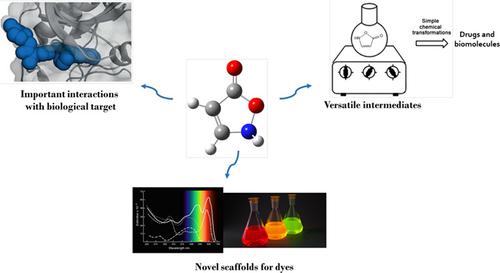当前位置:
X-MOL 学术
›
Chin. J. Chem.
›
论文详情
Our official English website, www.x-mol.net, welcomes your feedback! (Note: you will need to create a separate account there.)
Isoxazolone Reactivity Explained by Computed Electronic Structure Analysis
Chinese Journal of Chemistry ( IF 5.4 ) Pub Date : 2019-12-24 , DOI: 10.1002/cjoc.201900369 Giovanni Bella 1 , Antonio Santoro 1 , Massimiliano Cordaro 1 , Francesco Nicolò 1 , Giuseppe Bruno 1
Chinese Journal of Chemistry ( IF 5.4 ) Pub Date : 2019-12-24 , DOI: 10.1002/cjoc.201900369 Giovanni Bella 1 , Antonio Santoro 1 , Massimiliano Cordaro 1 , Francesco Nicolò 1 , Giuseppe Bruno 1
Affiliation

|
Isoxazol(2H)‐5‐one was chosen as a model molecule to study the structural features (α, β angles and carbonyl bond length) regarding lactone moiety in the isoxazolone species by computational calculation. DFT method with B3LYP 6‐311++G(2df,2p) basis set was used to carry out the optimization on a series (A and B families) of isoxazolones suitably substituted on double bond. The same computational method assisted by default solvent model was performed to evaluate the energies related to the tautomeric equilibrium of isoxazol(2H)‐5‐one and to the keto‐enol process (IRC). NPA (Natural Population Analysis) allowed us to understand how electron density is distributed on the heterocycle ring, highlighting reactive sites in chemical reactions and the possible interactions with biological targets.
中文翻译:

用电子结构分析方法解释异恶唑酮反应性
选择Isoxazol(2 H)-5-one作为模型分子,通过计算计算研究异恶唑酮类中内酯部分的结构特征(α,β角和羰基键长)。使用具有B3LYP 6-311 ++ G(2df,2p)基集的DFT方法对适当取代在双键上的一系列异恶唑酮(A和B家族)进行优化。使用默认溶剂模型辅助的相同计算方法来评估与异恶唑(2 H5-1)并进行酮-烯醇法(IRC)。NPA(自然人口分析)使我们能够了解电子密度如何在杂环上分布,突出了化学反应中的反应位点以及与生物靶标的可能相互作用。
更新日期:2019-12-25
中文翻译:

用电子结构分析方法解释异恶唑酮反应性
选择Isoxazol(2 H)-5-one作为模型分子,通过计算计算研究异恶唑酮类中内酯部分的结构特征(α,β角和羰基键长)。使用具有B3LYP 6-311 ++ G(2df,2p)基集的DFT方法对适当取代在双键上的一系列异恶唑酮(A和B家族)进行优化。使用默认溶剂模型辅助的相同计算方法来评估与异恶唑(2 H5-1)并进行酮-烯醇法(IRC)。NPA(自然人口分析)使我们能够了解电子密度如何在杂环上分布,突出了化学反应中的反应位点以及与生物靶标的可能相互作用。



























 京公网安备 11010802027423号
京公网安备 11010802027423号